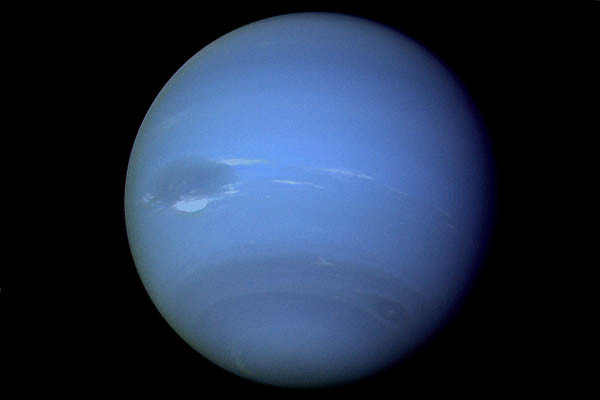How Did Neptune Form?
Although planets surround stars in the galaxy, how they form remains a subject of debate. Despite the wealth of worlds in our own solar system, scientists still aren't certain how planets are built. Currently, two theories are duking it out for the role of champion.
The first and most widely accepted, core accretion, works well with the formation of the terrestrial planets but has problems with giant planets such as Neptune. The second, the disk instability method, may account for the creation of giant planets.

The core accretion model
Approximately 4.6 billion years ago, the solar system was a cloud of dust and gas known as a solar nebula. Gravity collapsed the material in on itself as it began to spin, forming the sun in the center of the nebula.
With the rise of the sun, the remaining material began to clump together. Small particles drew together, bound by the force of gravity, into larger particles. The solar wind swept away lighter elements, such as hydrogen and helium, from the closer regions, leaving only heavy, rocky materials to create terrestrial worlds. But farther away, the solar winds had less impact on lighter elements, allowing them to coalesce and compose Neptune and other gas giants. In this way, asteroids, comets, planets, and moons were created.
Some exoplanet observations seem to confirm core accretion as the dominant formation process. Stars with more "metals" — a term astronomers use for elements other than hydrogen and helium — in their cores have more giant planets than their metal-poor cousins. According to NASA, core accretion suggests that small, rocky worlds should be more common than the more massive gas giants.
The 2005 discovery of a giant planet with a massive core orbiting the sun-like star HD 149026 is an example of an exoplanet that helped strengthen the case for core accretion.
"This is a confirmation of the core accretion theory for planet formation and evidence that planets of this kind should exist in abundance," said Greg Henry in a press release. Henry, an astronomer at Tennessee State University, Nashville, detected the dimming of the star.
In 2017, the European Space Agency plans to launch the CHaracterising ExOPlanet Satellite (CHEOPS), which will study exoplanets ranging in sizes from super-Earths to Neptune. Studying these distant worlds may help determine how planets in the solar system formed.
"In the core accretion scenario, the core of a planet must reach a critical mass before it is able to accrete gas in a runaway fashion," said the CHEOPS team.
"This critical mass depends upon many physical variables, among the most important of which is the rate of planetesimals accretion."
By studying how growing planets accrete material, CHEOPS will provide insight into how worlds grow.
In order for this model to work for giant planets such as Neptune, it would require a third element of migration. Some scientists propose that Neptune originally formed closer to the sun, then traveled outward to its present position once the gaseous disk dissipated.
The disk instability model
For massive gas giants like Jupiter, however, core accretion takes far too long. The cloud of material around the sun only lasts a short time it is either gathered up by planets or evaporates completely.
"Giant planets form really fast, in a few million years," Kevin Walsh, a researcher at the Southwest Research Institute in Boulder, Colorado, told Space.com. "That creates a time limit because the gas disk around the sun only lasts 4 to 5 million years."
The composition of Neptune is almost completely the light gas hydrogen, with a significant amount of helium, as well as some methane. A layer of methane above the clouds gives Neptune its blue color because the gas absorbs red light, according to NASA. Small traces of other elements exist in Neptune's atmosphere, as well. In order to capture these gases, Neptune needed to form its massive core quickly. The massive core could then gravitationally capture the lighter elements before solar winds swept them away.
According to a relatively new theory, disk instability, clumps of dust and gas are bound together early in the life of the solar system. Over time, these clumps slowly compact into a giant planet. These planets can form faster than their core accretion rivals, sometimes in as little as a thousand years, allowing them to trap the rapidly vanishing lighter gases. They also quickly reach an orbit-stabilizing mass that keeps them from death-marching into the sun.
Pebble accretion
The biggest challenge to core accretion is time — building massive gas giants fast enough to grab the lighter components of their atmosphere. Recent research on how smaller, pebble-sized objects fused together to build giant planets up to 1000 times faster than earlier studies.
"This is the first model that we know about that you start out with a pretty simple structure for the solar nebula from which planets form, and end up with the giant-planet system that we see," study lead author Harold Levison, an astronomer at the Southwest Research Institute (SwRI) in Colorado, told Space.com in 2015.
In 2012, researchers Michiel Lambrechts and Anders Johansen from Lund University in Sweden proposed that tiny pebbles, once written off, held the key to rapidly building giant planets.
"They showed that the leftover pebbles from this formation process, which previously were thought to be unimportant, could actually be a huge solution to the planet-forming problem," Levison said.
Levison and his team built on that research to model more precisely how the tiny pebbles could form planets seen in the galaxy today. While previous simulations, both large and medium-sized objects consumed their pebble-sized cousins at a relatively constant rate, Levison's simulations suggest that the larger objects acted more like bullies, snatching away pebbles from the mid-sized masses to grow at a far faster rate.
"The larger objects now tend to scatter the smaller ones more than the smaller ones scatter them back, so the smaller ones end up getting scattered out of the pebble disk," study co-author Katherine Kretke, also from SwRI, told Space.com. "The bigger guy basically bullies the smaller one so they can eat all the pebbles themselves, and they can continue to grow up to form the cores of the giant planets."
A Nice model
Originally, scientists thought that planets formed in the same part of the solar system they live in today. The discovery of exoplanets shook things up, revealing that at least some of the most massive objects could migrate.
In 2005, a trio of papers published in the journal Nature proposed that Neptune and the other giant planets were bound in near-circular orbits much more compact than they are today. A large disk of rocks and ices surrounded them, stretching out to about 35 times the Earth-sun distance, just beyond Neptune's present orbit. They called this the Nice model, after the city in France where they first discussed it.
As the planets interacted with the smaller bodies, they scattered most of them toward the sun. The process caused them to trade energy with the objects, sending Saturn, Neptune and Uranus farther out into the solar system. Eventually the small objects reached Jupiter, which sent them flying to the edge of the solar system or completely out of it.
Movement between Jupiter and Saturn drove Uranus and Neptune into even more eccentric orbits, sending the pair through the remaining disk of ices. Some of the material was flung inward, where it crashed into the terrestrial planets during the Late Heavy Bombardment. Other material was hurled outward, creating the Kuiper Belt.
As they moved slowly outward, Neptune and Uranus traded places. Eventually, interactions with the remaining debris caused the pair to settle into more circular paths as they reached their current distance from the sun.
Along the way, it's possible that one or even two other giant planets were kicked out of the system. Astronomer David Nesvorny of the Southwest Research Institute in Colorado has modeled the early solar system in search of clues that could lead to understanding its early history.
"In the early days, the solar system was very different, with many more planets, perhaps as massive as Neptune, forming and being scattered to different places," Nesvorny told Space.com
Follow Nola Taylor Redd on Twitter @NolaTRedd Facebook or Google+. Follow us at @Spacedotcom, Facebook or Google+.
Join our Space Forums to keep talking space on the latest missions, night sky and more! And if you have a news tip, correction or comment, let us know at: community@space.com.
Get the Space.com Newsletter
Breaking space news, the latest updates on rocket launches, skywatching events and more!

Nola Taylor Tillman is a contributing writer for Space.com. She loves all things space and astronomy-related, and always wants to learn more. She has a Bachelor's degree in English and Astrophysics from Agnes Scott College and served as an intern at Sky & Telescope magazine. She loves to speak to groups on astronomy-related subjects. She lives with her husband in Atlanta, Georgia. Follow her on Bluesky at @astrowriter.social.bluesky
